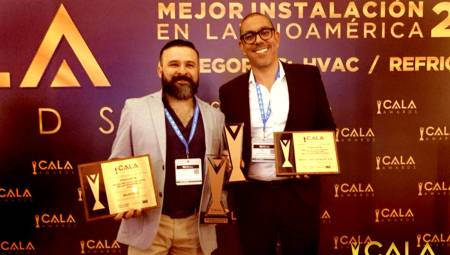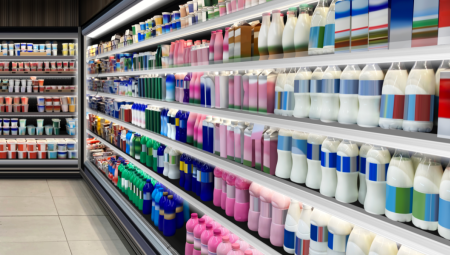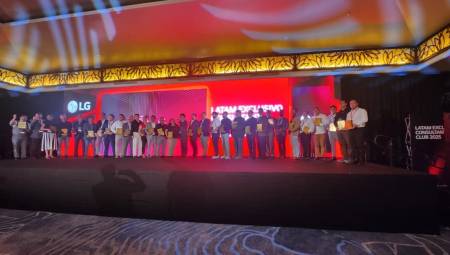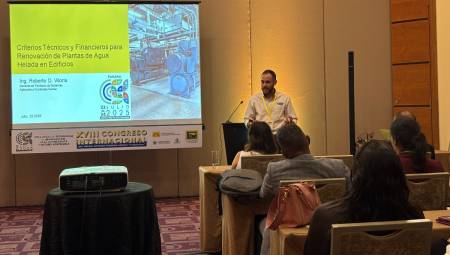USUAL STARTING REQUIREMENTS:
• Need to maintain a constant temperature in the water of the receptacle or glass.• Need to maintain an adequate ambient temperature inside the pool enclosure.• Need to maintain appropriate conditions of relative humidity in the enclosure to avoid condensation, among other issues.
In large enclosures, whether public or private, the usual solution that has proven to achieve appropriate results, with an energy balance in terms of consumption, is the solution by Heat Pump. This system, as it should be known, consists of two condensers, one of air and one of water and an evaporator, in this case by air. The treatment of the ambient air is carried out by passing the return air through the evaporator, where there is a condensation of a good part of the water vapor contained in it and then it is led to the coil or air battery of the condenser, where it is reheated to maintain the desired ambient temperature. It is usually supported with a second coil to the condenser, either electrical or water from an alternative source of heat. It should not be forgotten that a part of the indoor air is expelled to the outside to allow renewal.
For the treatment of the water of the glass, it is recirculated by the condenser of the Heat Pump (coolant – water), thus managing to maintain in the required conditions the temperature of the water in the glass. In many cases, support through auxiliary energy is necessary. This system is one of the most common, but not the only one, everything will depend on the characteristics of the enclosure, the available energies, other facilities that exist in the sports complex and, of course, the criteria of the designer.
There are other smaller sports facilities (small swimming pools in health facilities, spas, condominiums, private houses, etc.), in which the use of this type of technology implies a disproportionate increase, in terms of initial investment, in the energy consumption of the operation, and in terms of technical maintenance (equipment revisions and possible breakdowns).
For this type of smaller installations, another alternative is proposed with which similar results will be achieved, if not the same, with a much more contained energy consumption and a significant reduction in technical maintenance costs. The heart of the thermal system will be a conventional boiler-based installation with a diesel burner or preferably a gas burner, which is a less polluting energy. From it will be provided the amount of heat necessary to maintain in the desired conditions, both the water of the glass (through a plate exchanger appropriate to chlorinated water), and the ambient temperature (air conditioning or even in some cases radiators). The problem arises with the level of ambient humidity. Now, without the help of the Heat Pump, there is no cold source in which to condense the ambient water vapor. On the other hand, the idea of the total renovation of the environment by 100% external air should be discarded, since this would be an unjustifiable energy waste.

The first fan sucks air from inside the enclosure leading it to the recuperator, where the air will give its heat energy to the air that enters from the outside, and will transmit not only the sensitive heat it has, but a good part of the latent heat when a high percentage of the contained water vapor condenses. This is due to the low temperature of the air coming in from the outside. The performance achieved in the thermal exchange will be higher, the lower the temperature of the outside airIn this way, in the worst climatic moments in terms of consumption demand, the recovery and therefore the thermal use, will also be greater. The other fan will be responsible for introducing air from the outside to the recuperator, where, as has been said, this air will absorb the energy given by the exhaust air.
What is achieved, in short, is to throw the humidity outside, recovering the energy contained in the air before leaving the enclosure, this thanks to the Air -Air Energy Recuperator. In the event that the treatment of the ambient air is carried out through air conditioning, the recuperator will be installed inside it, always preceding the battery or hot water coil, where the final overheating of the air will be carried out.
In the case of installation by radiators, you can opt for the installation of a small water battery for the treatment of the incoming air, once the exchange has been carried out or introduce it directly. In this case, less recommended, care will be taken to discharge this air out of the reach of bathers. This last principle will always be observed and for any system, since the presence of air currents on the wet body produces a sudden cooling by surface evaporation, tremendously unpleasant, and even dangerous to health. In the case of the use of air conditioner for the treatment of ambient air, the air flow to be renewed through the recuperator, which does not always work with all outside air, must be calculated. To control the operation of the fans and therefore the level of relative humidity, a hygrostat must be installed in the enclosure. This will further reduce energy consumption and maintain a constant level of humidity.
A summary of the advantages of this system is:
• Lower Electricity Consumption• Lower Overall Energy Consumption• Lower Cost in Terms of Initial Investment• Lower Cost of Technical Maintenance• Greater Simplicity in Overall Installations
As a last recommendation and mainly in enclosures with intermittent use, it is very profitable to place plastic pool covers, which prevents the surface evaporation of the water from the glass, since this evaporation is continuous day and night.













